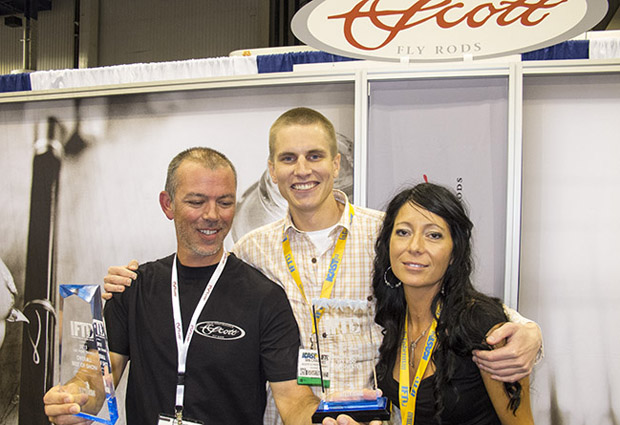 From Scratch—How Fly Rods Are Made
From Scratch—How Fly Rods Are Made
Zach Matthews / Itinerant Angler
[dropcap]I[/dropcap]f there’s one thing fly fisherman get worked up about, it’s fly rods. Golf addicts may expound for hours about a club head’s “sweet spot,” and ammunition reloaders go glassy-eyed talking about ballistics and shot patterns, but even these fanatics would be hard pressed to rival a shop full of anglers discussing “swing weight,” “modulus” and “action.” The funny thing is, most of these same experts have little idea how a graphite rod is made (and in the fly shop we’re all experts, at least when it comes to what we think a rod should be). The process is as fascinating as it is complicated. Knowing a thing or two about rod construction greatly increases your appreciation of what fly rods are… and yes, maybe what they should be.A graphite fly rod starts out as a sheet of carbon fiber that is impregnated with various types of glues or resins
Fundamentally, a graphite fly rod starts out as a sheet of carbon fiber that is impregnated with various types of glues or resins, depending on the manufacturer and the rod model. These “prepreg” sheets come in huge, glistening rolls, like an extra-jumbo tube of gift wrap. In order to make raw carbon fiber sheets into the tube shape of a fly rod, you need something to form it around—a mandrel. Mandrels are where the design process of a fly rod really gets started.
Contrary to a popular misconception, almost no multi-piece rod is cut from a single long blank
Obviously, if you want to create a rod “taper” (the ultimate shape of the rod tube), you have to start with the internal form. “Mandrels are made of stainless steel, and they require very precise machining, with tolerances often tighter than a tenth of a millimeter,” says Scott Fly Rods’ Ian Crabtree. Mandrels are designed on computers, and are typically made by machining companies to a rod manufacturer’s very detailed specs. Since the mandrel must go inside of a graphite rod tube, and since the tubes get very, very small (especially in the tip sections of 1- and 2-weights), there’s no room for error. In their smallest sizes, mandrels essentially resemble long steel needles (and of course they must be handled with extreme care). Gary Loomis (now consulting for Temple Fork Outfitters) confirms that most multi-piece fly rods get a different mandrel for each section, meaning “a four-piece rod will have four different forms.” (Contrary to a popular misconception, almost no multi-piece rod is cut from a single long blank, due to the difficulty of keeping a lengthy blank from twisting when it is pulled from the mandrel.)
Once a manufacturer has a mandrel (typically after a lot of prototyping), it’s time to roll out the blank
A sheet of carbon fiber is pulled from the roll and hand-cut with a sophisticated knife “that kind of resembles a box-cutter,” according to Scott’s Crabtree. Once cut, these sheets are called “flags” or “patterns.” For U.S. manufacturers, they always take the form of a trapezoid of some kind, since the tip will always be somewhat narrower than the butt (this goes for every section of the rod). According to rod designer and casting guru Jason Borger, these trapezoids may still wind up being quite complex, with multiple compound angles to create different actions. (In contrast, some very budget-conscious overseas manufacturers simply cut a rectangular pattern and allow all corners to overlap in a twist when rolled. These rods are typically sold in bubble packs in big-box stores).
“If you bend it, first it will ovalize, then it will crack out at the edges.”
But wait! Here the manufacturers have to deal with a serious design problem
If you make a graphite rod out of nothing more than impregnated carbon fiber, which is almost always aligned to run lengthwise down the blank, then it will snap the first time you bend it. “Think of it like a drinking straw,” says Paul Johnson, formerly of Sage. “If you bend it, first it will ovalize, then it will crack out at the edges.” TFO’s Gary Loomis analogizes an unreinforced rod to an egg: “It’s very strong if you’re pushing from outside, but much weaker when the stress comes from inside. That’s how come a little chick can break out of its egg so easily.” To prevent this, rod makers use something called “scrim.” Scrim is a reinforcing material that is aligned perpendicularly to the carbon fiber of the rod. Once rolled, it gives the rod hoop strength that helps it resist ovalization. “In the old days,” says Johnson, “scrim was always fiberglass, but in recent years we’ve been able to use carbon fiber.” Some manufacturers use a chopped mat of “paper carbon” scrim, like particle board, while others use a unidirectional product that allows all the scrim fibers to be aligned into hoops. And, of course, many rods are still made with fiberglass scrim, to maximize strength and minimize cost.
Once rolled, the scrim is sandwiched in between layers of carbon, meaning if you cut a cross-section you’d see scrim, then carbon, then more scrim, etc
Depending on how strong the manufacturer needs the rod section to be, the scrim flag might be cut wide, to cover all of the main carbon fiber flag, or narrower, giving less reinforcement.
Matthew is the owner and editor of The Itinerant Angler and the host of the podcast. He is also a national print magazine writer and photographer, providing content to a wide variety of publications. If you need to contact him: ZachMatthews@gmail.com.
NOTE: Featured Image from left to right Jim Bartschi, Ian Crabtree and Theresa Van Nooten from Scott Fly Rods.




